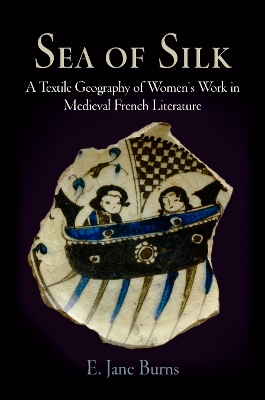The Middle Ages
2 total works
The story of silk is an old and familiar one, a tale involving mercantile travel and commercial exchange along the broad land mass that connects ancient China to the west and extending eventually to sites on the eastern Mediterranean and along sea routes to India. But if we shift our focus from economic histories that chart the exchange of silk along Asian and Mediterranean trade routes to medieval literary depictions of silk, a strikingly different picture comes into view. In Old French literary texts from the twelfth and thirteenth centuries, emphasis falls on production rather than trade and on female protagonists who make, decorate, and handle silk.
Sea of Silk maps a textile geography of silk work done by these fictional women. Situated in northern France and across the medieval Mediterranean, from Saint-Denis to Constantinople, from North Africa to Muslim Spain, and even from the fantasy realm of Arthurian romance to the historical silkworks of the Norman kings in Palermo, these medieval heroines provide important glimpses of distant economic and cultural geographies. E. Jane Burns argues, in brief, that literary portraits of medieval heroines who produce and decorate silk cloth or otherwise manipulate items of silk outline a metaphorical geography that includes France as an important cultural player in the silk economics of the Mediterranean.
Within this literary sea of silk, female protagonists who "work" silk in a variety of ways often deploy it successfully as a social and cultural currency that enables them to traverse religious and political barriers while also crossing lines of gender and class.
Clothing was used in the Middle Ages to mark religious, military, and chivalric orders, lepers, and prostitutes. The ostentatious display of luxury dress more specifically served as a means of self-definition for members of the ruling elite and the courtly lovers among them. In Courtly Love Undressed, E. Jane Burns unfolds the rich display of costly garments worn by amorous partners in literary texts and other cultural documents in the French High Middle Ages.
Burns "reads through clothes" in lyric, romance, and didactic literary works, vernacular sermons, and sumptuary laws to show how courtly attire is used to negotiate desire, sexuality, and symbolic space as well as social class. Reading through clothes reveals that the expression of female desire, so often effaced in courtly lyric and romance, can be registered in the poetic deployment of fabric and adornment, and that gender is often configured along a sartorial continuum, rather than in terms of naturally derived categories of woman and man. The symbolic identification of the court itself as a hybrid crossing place between Europe and the East also emerges through Burns's reading of literary allusions to the trade, travel, and pilgrimage that brought luxury cloth to France.

